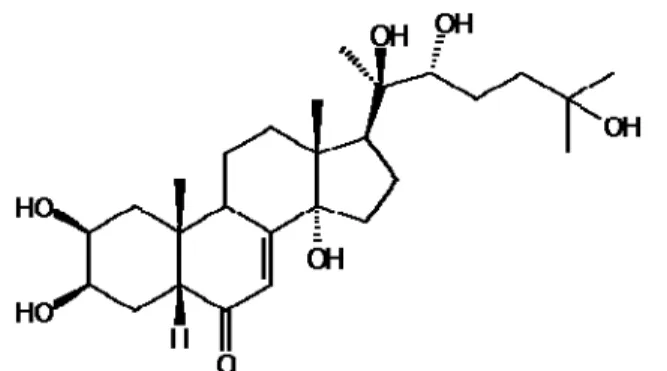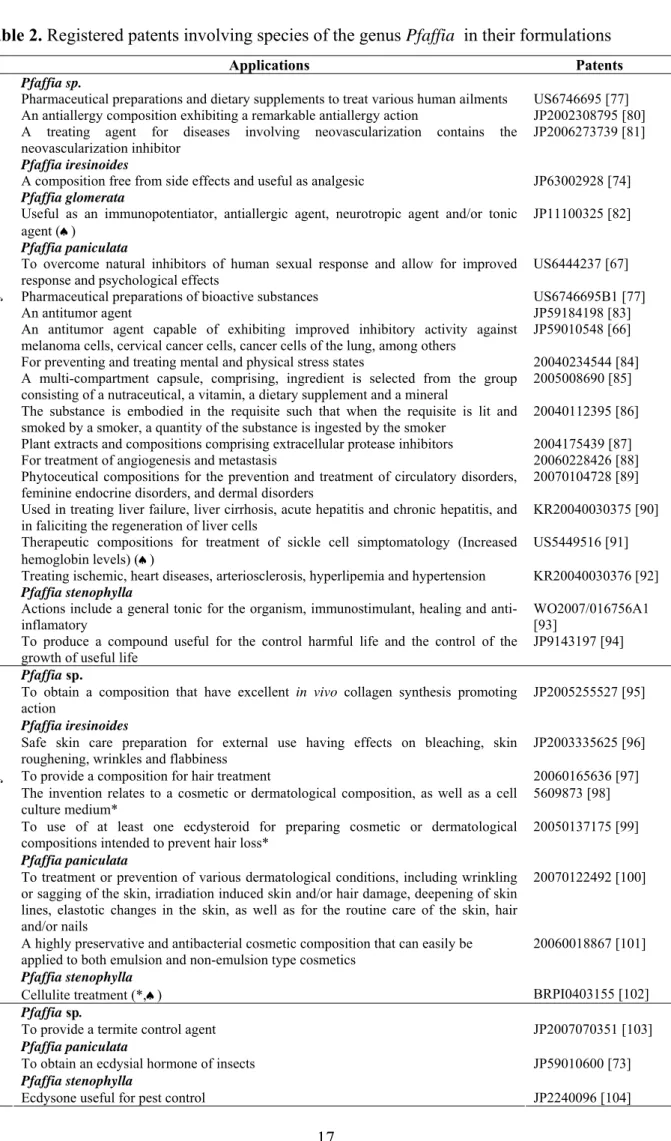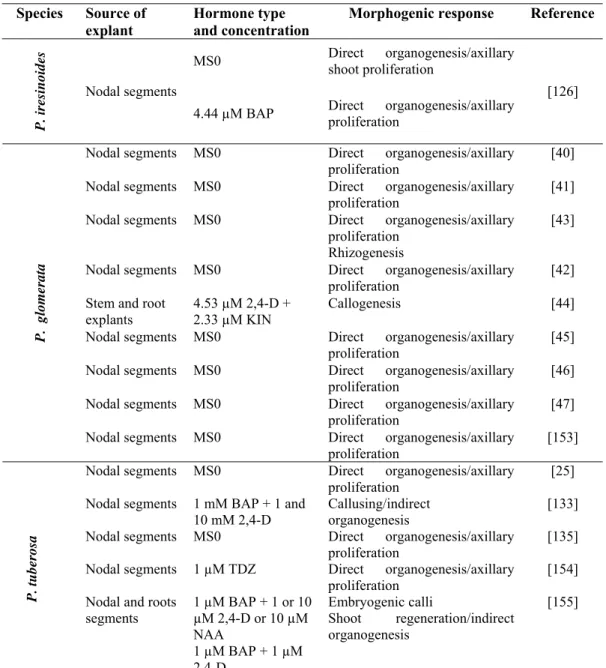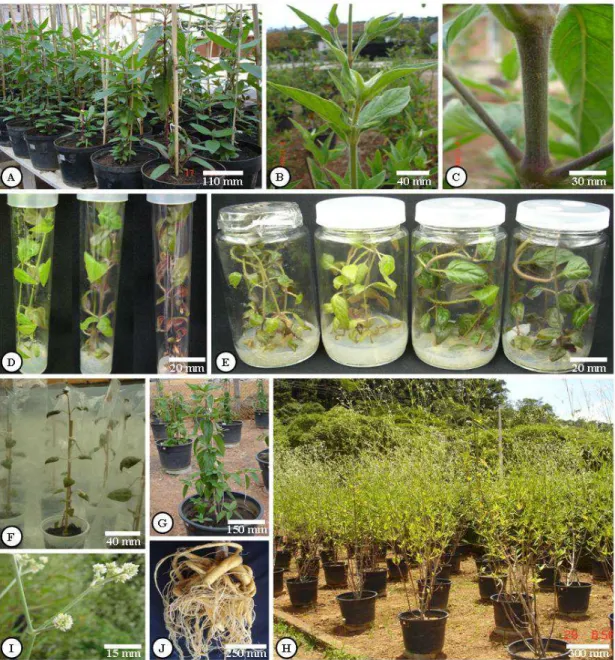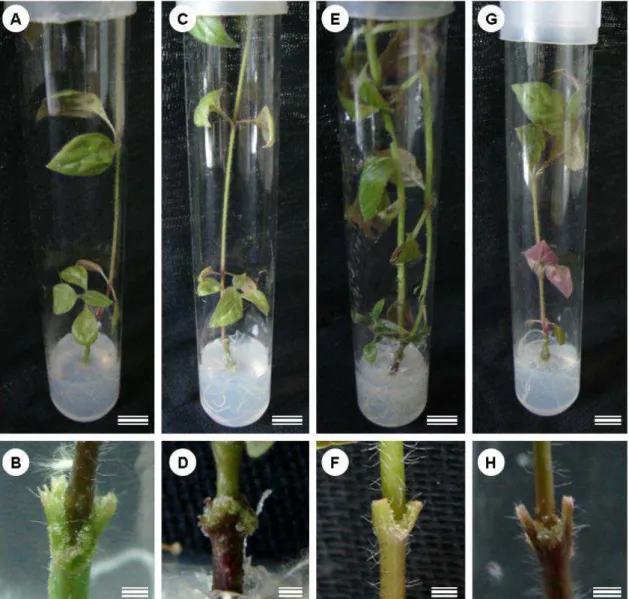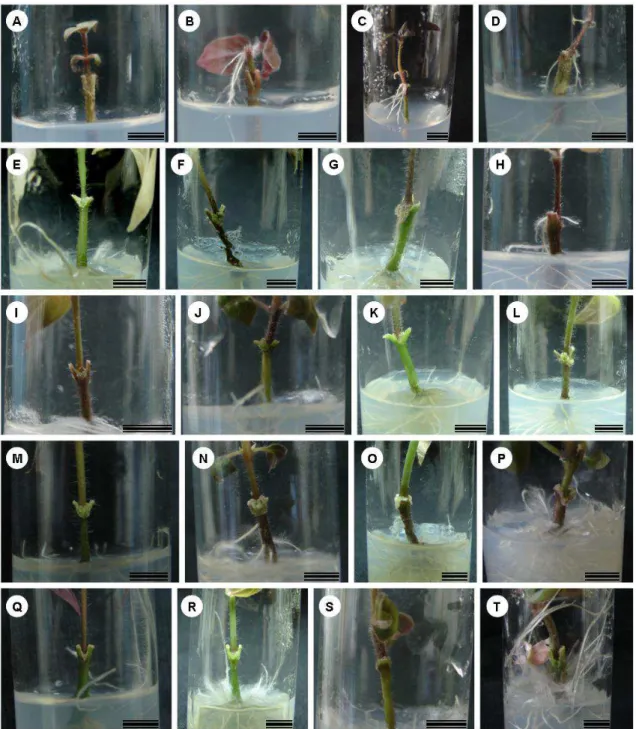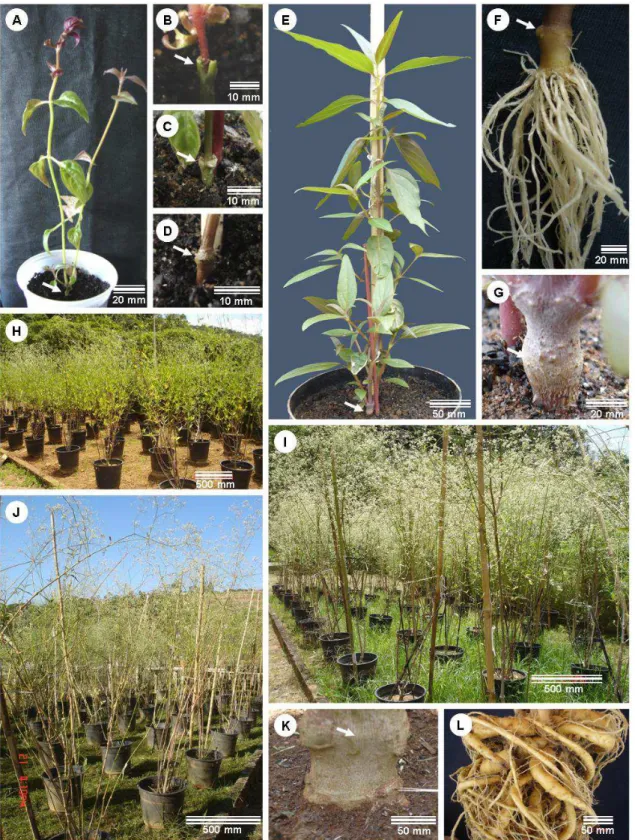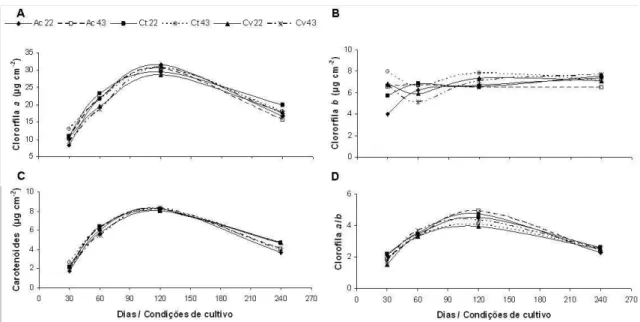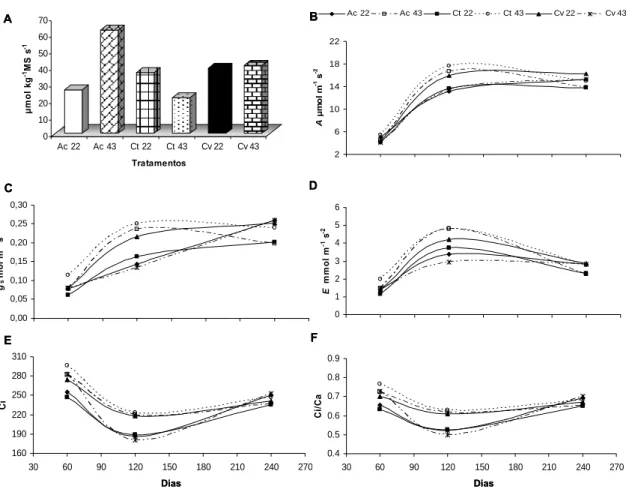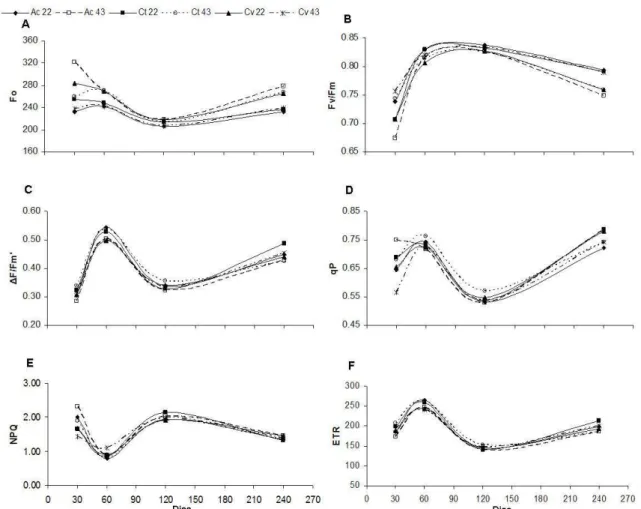LOURDES IAREMA
Enxertia e propagação
in vitro
de fáfia [
Pfaffia glomerata
(Spreng.) Pedersen]
Tese apresentada à Universidade Federal de Viçosa, como parte das exigências do Programa de Pós-Graduação em Botânica para obtenção do Título de Doctor Scientiae
VIÇOSA
Ficha catalográfica preparada pela Seção de Catalogação e Classificação da Biblioteca Central da UFV
T
Iarema, Lourdes, 1976-
I11e Enxertia e propagação in vitro de fáfia [Pfaffia
2008 glomerata (Spreng.) Pedersen] / Lourdes Iarema. – Viçosa, MG, 2008.
xiv, 170f.: il. (algumas col.) ; 29cm.
Orientador: Wagner Campos Otoni.
Tese (doutorado) - Universidade Federal de Viçosa. Inclui bibliografia.
1. Plantas medicinais. 2. Enxertia. 3. Pfaffia glomerata - Enxertia. 4. Plantas medicinais - Propagação. 5. Propaga-
cão vegetativa. 6. Folhas - Anatomia. 7. Planta - Anatomia. I. Universidade Federal de Viçosa. II.Título.
LOURDES IAREMA
Enxertia e propagação
in vitro
de fáfia [
Pfaffia glomerata
(Spreng.) Pedersen]
Tese apresentada à Universidade Federal de Viçosa, como parte das exigências do Programa de Pós-Graduação em Botânica para obtenção do Título de Doctor Scientiae
APROVADA: 10 de junho de 2008.
___________________________ _______________________________ Profª. Luzimar Campos da Silva Prof. Carlos Roberto de Carvalho
(Co-orientadora) (Co-orientador)
___________________________ ________________________________ Prof. Rogério Ferreira Ribas Prof. Vespasiano Borges de Paiva Neto
___________________________ Prof. Wagner Campos Otoni
Vencer os outros não é uma grande vitória
Vitorioso é aquele que consegue vencer a si mesmo A vitória sobre nós mesmos é muito mais difícil,
Pois requer muita coragem, mais disciplina, Mais perseverança e, maiores desafios...
Ao meu marido Rogério, aos meus pais Miguel e Erna, e, a minha irmã Alice,
AGRADECIMENTOS
A Deus, por todos os momentos.
À minha família, pela confiança, compreensão e apoio durante todos os momentos da minha vida, sem os quais jamais teria atingido mais esta etapa.
À Universidade Federal de Viçosa (UFV) e, em especial, ao Programa de Pós-Graduação em Botânica, pela oportunidade de realização do curso.
À Coordenação de Aperfeiçoamento de Pessoal de Nível Superior (CAPES), pela concessão da bolsa de estudos.
Ao professor Wagner Campos Otoni, pela orientação, carinho, amizade, confiança, experiências compartilhadas e apoio, nessa importante fase de aprendizado e preparação para o mercado de trabalho.
Aos professores Luzimar Campos da Silva, Luiz Cláudio de Almeida Barbosa e Carlos Roberto de Carvalho, pela co-orientação, aconselhamentos, auxílio, críticas, sugestões e motivação dispensada nesse trabalho.
Aos professores Leandro Grossi de Freitas e Rogério Ferreira Ribas, pela colaboração e dedicação em importantes etapas do trabalho.
Ao professor Cosme Damião Cruz, pela colaboração nas análises e interpretações estatísticas.
Aos professores Marco Antônio Oliva Cano, Vicente Wagner Dias Casali, Fernando Luiz Finger e Vitor Hugo pela disponibilidade de infra-estrutura essencial à condução dos experimentos.
A todos os mestres envolvidos, direta ou indiretamente, em minha formação, e em especial, ao professor Eldo Antônio Monteiro da Silva pelo exemplo de conduta, profissionalismo e, principalmente, perseverança.
Aos técnicos da UFV, Zé Maria, Vânia e Edite (DBV), Carlos (DPS), Rogério (UCP), Zé Luiz (LASA), Eduardo, Antônio Cordeiro (DBV) e Lili (LCTII), pela atenção, auxílio e sugestões.
Aos estagiários Virgílio Loriato e Diego Rocha, aos colegas Katryne, Rony, Marcela, Fabiana, Ana Claudia, André, Donizetti, Eduardo, Cláudio pela valiosa contribuição e auxílio direto na obtenção desses resultados.
Aos demais colegas do LCTII e do laboratório de Anatomia Vegetal, pelo convívio e apoio recebido, no qual eu agradeço em nome de uma pessoa que eu acho que representa o verdadeiro sentido das palavras amizade e profissionalismo, Ana Claudia, obrigada pelos inúmeros momentos de ausência em sua família em função da dedicação neste trabalho.
Ao Patch e a Gabriela pela compreensão e convívio.
A todos os meus colegas de Curso e dos Laboratórios que passei, funcionários e professores desta instituição, pessoas os quais tornaram o ambiente de agradável convívio e, contribuíram para o progresso profissional e pessoal.
Ao meu marido pelo auxílio, ausência, compreensão, apoio e companheirismo durante mais esta jornada.
Aos meus pais e a minha irmã querida pela compreensão, paciência e apoio, que ajudaram a suportar a distância nestes últimos anos.
BIOGRAFIA
LOURDES IAREMA, filha de Miguel Iarema Sobrinho e Erna Iarema, nasceu em 29 de agosto de 1976, em Matelândia, Estado do Paraná.
No ano de 1999 concluiu o Curso de Licenciatura Plena em Ciências Biológicas pela Universidade do Estado de Mato Grosso (UNEMAT) – Campus Universitário de Alta Floresta.
Em Agosto de 2001 iniciou, na UNEMAT, o Programa de Pós-graduação “Lato Sensu” em Educação Ambiental Párea a Conservação da Amazônia Norte-Matogrossense, submetendo-se à defesa em 19 de agosto de 2003.
Em março de 2002 iniciou o curso de mestrado em Botânica, na Universidade Federal de Viçosa (UFV), submetendo-se à defesa em 20 de fevereiro de 2004.
ÍNDICE
RESUMO ... ix
ABSTRACT ... xii
INTRODUÇÃO GERAL ... 1
Referências Bibliográficas ... 6
CAPÍTULO 1. The Brazilian ginseng(Pfaffia sp.) ... 10
The genus Pfaffia (Amaranthaceae) ... 10
Economic importance ... 12
Chemical and pharmacological properties ... 13
Pfaffia glomerata ... 16
Pfaffia iresinoides ... 20
Pfaffia paniculata ... 20
Pfaffia tuberosa ... 21
Conventional propagation and in vitro propagation ... 21
Pfaffia glomerata ... 23
Pfaffia tuberosa ... 26
Pfaffia iresinoides ... 28
General micropropagation protocol ... 28
Disinfection and plant establishment ... 28
Shoot proliferation and rooting ... 30
Acclimatization and transplanting ... 30
References ... 32
CAPÍTULO 2. Enxertia in vitro em fáfia [Pfaffia glomerata (Spreng.) Pedersen]... 41
Introdução ... 41
Material e Métodos ... 44
Origem do material vegetal e condições de crescimento ... 44
Enxertia in vitro ... 45
Características avaliadas in vitro ... 45
Delineamento experimental ... 46
Resultados ... 47
Enxertia in vitro ... 47
Discussão ... 52
Referências Bibliográficas ... 57
CAPÍTULO 3. Desenvolvimento ex vitro de fáfia [Pfaffia glomerata (Spreng.) Pedersen] propagadas pela enxertia in vitro ... 61
Introdução ... 61
Material e Métodos ... 64
Aclimatização ... 64
Avaliação de parâmetros fisiológicos ... 65
Pigmentos cloroplastídicos ... 65
Determinação das trocas gasosas ... 65
Avaliações em condições ex vitro ... 65
Avaliações da taxa fotossintética in vitro ... 66
Determinação da fluorescência da clorofila a ... 66
Análises de campo ... 66
Características agronômicas ... 67
Determinação do índice de galhas ... 67
Delineamento experimental ... 67
Resultados ... 68
Aclimatização ... 68
Parâmetros fisiológicos ... 68
Análises de campo ... 74
Discussão ... 82
Referências Bibliográficas ... 88
CAPÍTULO 4. Caracterização histológica da enxertia in vitro de fáfia [Pfaffia glomerata (Spreng.) Pedersen] ... 92
Introdução ... 92
Material e Métodos ... 95
Análise histológica ... 95
Resultados ... 98
Discussão ... 104
Referências Bibliográficas ... 110
CAPÍTULO 5. Produção de β-ecdisona em acessos de fáfia [Pfaffia glomerata (Spreng.) Pedersen] propagados via enxertia in vitro ... 114
Introdução ... 114
Material e Métodos ... 116
Análise química ... 117
Delineamento experimental ... 118
Resultados ... 119
Discussão ... 125
Referências Bibliográficas ... 132
CAPÍTULO 6. Propagação in vitro de fáfia [Pfaffia glomerata (Spreng.) Pedersen] .. 136
Introdução ... 136
Material e Métodos ... 138
Material vegetal ... 138
Características avaliadas ... 138
Área foliar ... 139
Pigmentos cloroplastídicos ... 139
Avaliações da taxa fotossintética ... 139
Determinação da fluorescência da clorofila a ... 139
Determinação de macro e micronutrientes ... 140
Análise em microscopia de luz ... 140
Análise em microscopia eletrônica de varredura ... 140
Perda de água do sistema ... 141
Delineamento experimental ... 141
Resultados ... 142
Discussão ... 155
Referências Bibliográficas ... 164
RESUMO
IAREMA, Lourdes. D.Sc. Universidade Federal de Viçosa, junho de 2008. Enxertia e propagação in vitro de fáfia [Pfaffia glomerata (Spreng.) Pedersen]. Orientador: Wagner Campos Otoni. Co-orientadores: Luzimar Campos da Silva, Carlos Roberto de Carvalho e Luiz Cláudio de Almeida Barbosa.
Pfaffia glomerata, popularmente conhecida como Ginseng brasileiro, é uma importante espécie medicinal cuja demanda no mercado e a forma de extrativismo levaram a sua inclusão na lista de espécies prioritárias para a conservação. Apresenta grande diversidade genética entre suas populações naturais, sendo essa variabilidade tanto na produção de biomassa das raízes, órgão de interesse na espécie, quanto na concentração de princípio ativo (β-ecdisona). Dessa forma, o presente trabalho teve como objetivos: (a) avaliar a eficiência da enxertia in vitro na propagação de dois acessos de Pfaffia glomerata, visando a estabelecer combinação compatível entre um acesso de elevada (2202) e um de baixa produção do princípio ativo (2209), para aumentar a produção do composto de interesse comercial; e (b) analisar o potencial fotoautotrófico de P. glomerata propagadas in vitro, comparando-se parâmetros fisiológicos e estruturais das plantas propagadas sob condições heterotróficas, fotomixotrófica e fotoautrófica. Na enxertia in vitro foram utilizados segmentos internodais como hipobioto e ápice caulinar como epibioto, de plantas cultivadas in
ABSTRACT
IAREMA, Lourdes. D.Sc. Universidade Federal de Viçosa, june 2008. Grafting and propagation in vitro of fafia [Pfaffia glomerata (Spreng.) Pedersen]. Adviser: Wagner Campos Otoni. Co-advisers: Luzimar Campos da Silva, Carlos Roberto de Carvalho and Luiz Cláudio de Almeida Barbosa.
Pfaffia glomerata, popularly known as Brazilian Ginseng, is an important medicinal species whose market demand and extractivism form led to its inclusion in the priority conservation species list. It presents great genetic diversity among its natural populations, being this variability expressed both in root biomass production, organ of interest of the species, as in the active principle content (β-ecdysone). Thereby, the present work aimed: (a) to evaluate in vitro micrografting efficiency in two P. glomerata accessions to establish a compatible combination between a low- (2202) and a high-producing (2209) β-ecdysone accessions, in order to increase the production of the commercial interest compound; and (b) to evaluate the photoautotrophic capacity of
P. glomerata propagated in vitro by comparison of physiological and structural parameters under heterotrophic, photomixotrophic and photoautotrophic conditions. In
in vitro micrografting, internodal segments and stem apexes, obtained from in vitro
propagated plants, were used as rootstock and as scion, respectively, in order to establish reciprocal combinations between the accessions, self-micrografting, and comparisons with non-micrografted counterparts. Evaluations were made concerning the connection percentage and growing features of graftings during in vitro stage (at 30 days) and survival and growing of micrografted plants both in vitro as in ex vitro
INTRODUÇÃO GERAL
O aumento da demanda por produtos naturais vem acompanhado por dificuldades em assegurar bom suprimento das plantas medicinais, devido ao decréscimo nas reservas naturais, resultante da forma de exploração a que algumas espécies são submetidas, além de dificuldades técnicas em cultivar plantas silvestres.
Considerando a importância do cultivo in vitro de espécies ameaçadas, tanto para propagação clonal em larga escala e como ferramenta para subsidiar estudos de otimização da produção de princípios ativos, informações sobre as respostas fisiológicas sob diferentes condições de cultivo são fundamentais para auxiliar esses objetivos.
Pfaffia pertence à família Amaranthaceae, que possui distribuição cosmopolita, inclui cerca de 170 gêneros e 2.000 espécies, sendo que no Brasil ocorrem 20 gêneros nativos e aproximadamente 100 espécies (Souza & Lorenzi, 2005).
Espécies do gênero Pfaffia são utilizadas na medicina popular, devido a suas propriedades químicas (Martins & Nicoloso, 2004). Algumas como P. iresinoides, P. glomerata, P. jubata, P. paniculata e P. tuberosa já têm suas propriedades medicinais confirmadas com o isolamento de compostos bioativos de suas raízes (Nakai et al., 1984; Nishimoto et al., 1984; 1986; 1987; 1988; Shiobara et al., 1992; 1993).
O Brasil é o mais importante centro de coleta de espécies do gênero (Corrêa Júnior et al., 2006a; 2006b), sendo conhecidas principalmente como ginseng-brasileiro e fáfia, também denominada paratudo, corango (Oliveira, 1986), corrente, sempre-viva, batata-do-mato, ou suma no mercado internacional (Corrêa Júnior et al., 2006a; 2006b). Utilizada há séculos pelos índios brasileiros na cura e prevenção de doenças, a fáfia (Pfaffia glomerata (Spreng.) Pedersen) só teve suas propriedades medicinais comprovadas cientificamente depois de levada ao Japão (Ming & Corrêa Júnior, 2004; Corrêa Júnior et al., 2006a; 2006b).
P. glomerata é estimado em 10% ao ano (Corrêa Júnior & Ming, 2004), levando à inclusão na relação de espécies prioritárias para conservação (Vieira et al., 2002).
Os principais constituintes isolados das raízes de Pfaffia são estigmasterol, sitosterol, alantoína, ecdisteróides, triterpenóides e nortriterpenóides (Nakai et al., 1984; Nishimoto et al., 1984; Festucci-Buselli et al., 2008). Entre os constituintes presentes na
P. glomerata, destaca-se o composto 20-hidroxiecdisona ou β-ecdisona (20E), um
ecdisteróide análogo dos hormônios de insetos envolvidos na ecdise (Dinan, 2001). Fitoesteróides são produtos da biossíntese de terpenos e suas estruturas variam de acordo com o número, localização e posição das hidroxilas substituintes no anel esteroidal (Báthori & Pongrácz, 2005). O papel dos ecdisteróides nas plantas pode ser considerado em nível de família ou planta, porque nem todas as plantas da mesma família contem ecdisteróides e aquelas que contêm, diferem no conteúdo (Baltaev, 2000). A distribuição de espécie contendo ecdisteróides entre famílias e gêneros é algo ainda inexplicável, sugere-se que sua distribuição ocorra ao acaso (Dinan et al., 2001).
A produção de 20E e demais metabólitos são as principais características relacionadas ao aspecto medicinal da fáfia, sendo o teor de 20E freqüentemente utilizado nas avaliações de cultivo e seleção de genótipos (Magalhães, 1998; Correia Júnior, 2003; Figueiredo, 2004). Atualmente, devido à grande demanda de ginseng brasileiro para a produção de medicamentos, buscam-se alternativas para a produção de matéria-prima homogênea e de qualidade (Flores et al., 2006).
A tecnologia do cultivo in vitro pode ser aplicada em plantas medicinais pela propagação clonal in vitro, cultura de calos e de células em suspensão, visando a produção de compostos secundários de interesse farmacêutico, cosmético e alimentar (Rout et al., 2000; Gómez-Galera et al., 2007). A exploração da capacidade biossintética de várias culturas celulares tem ocorrido nas últimas décadas e novos conhecimentos têm sido relatados para grande variedade de produtos naturais (Alfermann & Petersen, 1995; Gómez-Galera et al., 2007).
Nesse contexto, o cultivo in vitro de tecidos e células vegetais constitui uma alternativa promissora para o suprimento de material vegetal. As técnicas de propagação
Buscando maximizar o processo de propagação in vitro de P. glomerata foram conduzidos estudos utilizando carvão ativado e concentração de macronutrientes (Nicoloso et al., 2001), fontes e doses de ferro (Nicoloso & Ferrão, 2001), níveis de nitrogênio, fósforo (Russowski & Nicoloso, 2003) e sacarose (Skrebsky et al., 2004; Maldaner et al., 2007). No cultivo in vitro, as plantas perdem parcialmente o autotrofismo e, consequentemente, necessitam de uma fonte exógena de carboidratos, sendo a sacarose o carboidrato mais apropriado para a multiplicação in vitro de P. glomerata (Nicoloso et al., 2003). O aumento, a eliminação e, ou, a redução da concentração de carboidratos no meio de cultura pode ser um dos fatores determinantes no sucesso da aclimatização (Pospísilová et al., 1999; Skrebsky et al., 2004). A redução de açúcar no meio de cultivo apresenta vantagens, como a prevenção do rápido crescimento de bactérias e de fungos no meio de cultivo, a redução de custos e o aumento na sobrevida das plantas durante a aclimatização (Kozai & Kubota, 2001; Xiao & Kozai, 2006).
Outro fator que pode ser determinante neste processo é o tipo de vedação utilizado no recipiente de cultura. Geralmente, os explantes in vitro são mantidos em frascos vedados, porém, dependendo do tipo de vedação encontram-se baixas trocas gasosas entre os ambientes externo e interno (Chen, 2004; Tsay et al., 2006). As modificações na concentração destes gases afetam o crescimento e a morfogênese de algumas espécies de plantas em vários sistemas de cultivo in vitro (Marino & Berardi, 2004; Gonçalves et al., 2008). As trocas gasosas no ambiente de cultura estão diretamente relacionadas com a umidade relativa, temperatura do ar e concentração de CO2 no ambiente de cultivo (Shim et al., 2003).
A elevada umidade relativa e a concentração de CO2 no ambiente interno dos
A enxertia in vitro apresenta-se como ferramenta para estudos de produção dos metabólitos secundários nessa planta medicinal, fundamentada na enxertia recíproca de genótipos divergentes na produção, baseada na diferença apresentada por indivíduos em caracteres relacionados ao teor de β-ecdisona e produção de raízes. A otimização da produção in vitro de Pfaffia está relacionada à biossíntese de metabólitos secundários e à manutenção da diversidade genética. A redução dos custos pelo uso dessa técnica é fundamental para a produção comercial de mudas, bem como para a maximização da produção do princípio ativo de interesse.
P. glomerata não é uma espécie domesticada. Uma única população pode demonstrar ampla variabilidade, seja associada às diferenças no desenvolvimento, na resistência a pragas e doenças, nas respostas à fertilidade do solo e na produtividade individual ou genética, que pode ser expressa nas plantas com diferentes conteúdos de constituintes bioativos, responsáveis pelos efeitos terapêuticos, sendo que as populações que apresentam variação genética são difíceis de cultivar (Montanari Júnior, 2005; Montanari Júnior & Perecin, 2006).
A domesticação desta espécie aumenta as possibilidades de obtenção de plantas com menor heterogeneidade e com maior produtividade, podendo ser facilitada pela utilização da técnica de enxertia in vitro como método de propagação.
A enxertia in vitro foi desenvolvida na busca de plantas cítricas livres de vírus (Murashige et al., 1972), e, posteriormente, utilizada para maximizar a limpeza clonal (Navarro et al., 1975). Além de permitir a obtenção de plantas isentas de vírus e outras doenças, a enxertia in vitro pode contribuir para estudos relacionados com a incompatibilidade entre epibioto e hipobioto, e com aspectos fisiológicos e histológicos envolvidos no processo (Jonard, 1986; George, 1993; Hartmann et al., 1997).
Dentre as vantagens da enxertia in vitro, destacam-se a formação de bancos de plantas matrizes para fornecimento de borbulhas certificadas; a possibilidade de intercâmbio de mudas, assegurando o estado fitossanitário; a manutenção de bancos de germoplasma livres de vírus; a possibilidade de aumentar a produtividade nos plantios comerciais e o rejuvenescimento de essências florestais (Paz & Pasqual et al., 1998).
A enxertia in vitro pode também ser uma alternativa para a otimização da produção do princípio ativo de plantas medicinais que possuem genótipos divergentes na produção, bem como na seleção de plantas resistentes a pragas e doenças.
sobre o crescimento e o desenvolvimento dos enxertos (Bandeira, 2006). Pois afetam diretamente o vigor da variedade da copa enxertada, estando relacionados diretamente ao genótipo e suas relações, induzindo diferenças marcantes no tamanho da copa e na sua produção (Schafer et al., 2001).
Em citros, os hipobiotos respondem com diferentes níveis de crescimento, influenciando no tempo de obtenção da muda em decorrência das características dos substratos e das restritas condições dos recipientes (Fochesato et al., 2007). Portanto, o manejo adequado em relação ao ambiente, as técnicas nutricionais, bem como a seleção do material vegetal, são fatores que influenciam diretamente no processo de crescimento da enxertia, sendo a produção de hipobiotos homogêneos, vigorosos e de alta produtividade fundamentais nesse processo.
Referências Bibliográficas
ALFERMANN, A.W.; PETERSEN, M. 1995. Natural product formation by plant cell biotechnology. Plant Cell, Tissue and Organ Culture, 43:199-205.
BALTAEV, U.A. 2000. Phytoecdysteroids: structure, sources, and biosynthesis in plants. Russian Journal Bioorganic Chemistry, 26:799–831
BÁTHORI M, PONGRÁCZ, Z. 2005. Phytoecdysteroids – from isolation to their effects on humans. Current Medicinal Chemistry, 12:153–172
BANDEIRA, F.S.; XAVIER, A.; OTONI, W.C.; DIAS, J.M.M. 2006. Enxertia in vitro na propagação de clones de Eucalyptus urophylla e E.grandis. Pesquisa Agropecuária Brasileira, 41:223-232.
BARROS, F.A.R.; STRINGHETA, P.C. 2006. Microencapsulamento de antocianinas – uma alternativa para o aumento de sua aplicabilidade como ingrediente alimentício. Biotecnologia Ciência & Desenvolvimento, 36:18-24.
CHEN, C. 2004. Humidity in plant tissue culture vessels. Biosystems Engineering, 88:231-241.
CORREIA JÚNIOR, C. 2003. Estudo agronômico da fáfia (Pfaffia glomerata (Spreng.) Pedersen): sazonalidade na produção de raízes e conteúdos de beta-ecdisona em diferentes indivíduos de São Paulo, Paraná e Mato Grosso do Sul. Doutorado (Horticultura), Botucatu: UNESP/FCA. 94 p.
CORRÊA JÚNIOR, C.; MING, L. C. 2004. Fáfia (Pfaffia glomerata (Spreng.) Pedersen: o ginseng brasileiro.. In: Alexiades, M.N.; Shanley, P. (Org.). Productos florestales, medios de subsistencia y conservacion: estudios de caso sobre sistemas de manejo de produtos florestales no maderables. Jacarta: CIFOR. 3:349-363.
CORRÊA JÚNIOR, C.; CORTEZ, D.A.G.; MING, L. C.; SOARES, W. 2006a. Fáfia – O ginseng brasileiro (Pfaffia glomerata (Sprengel) Pedersen): Aspectos Agronômicos e Fitoquímicos. Curitiba: Clichetec, 22p.
CORREA JÚNIOR, C.; MING, L. C. 2006b. Fáfia, ginseng brasileño. In: LÓPEZ, C.; SHANLEY, P.; CRONKLETON. (ORG.). Riquezas del bosque: frutas, remedies y artesanías en América Latina. Santa Cruz: Centro para la investigación forestal internacional, p.82-86. Disponível em: www.cifor.cgiar.org/publications, Acesso em: 20/07/2007.
DAMI, I.; HUGLES, H. 1995. Leaf anatomy and water loss of in vitro PEG-treated ‘Valiant’ grape. Plant Cell, Tissue and Organ Culture, 42:179-184.
DINAN, L. 2001. Phytoecdysteroids: biological aspects. Phytochemistry, 57:325-339.
EMPRESA BRASILEIRA DE PESQUISA AGROPECUÁRIA - EMBRAPA. 1999. Manual de análises químicas de solos, plantas e fertilizantes. Brasília, Embrapa Comunicação para Transferência de Tecnologia, 370p.
FESTUCCI-BUSELLI, R.A.; CONTIM, L.A.S.; BARBOSA, L.C.A.; STUART; J.J.; OTONI, W.C. 2008. Biosynthesis and potential functions of the ecdysteroid 20-hydroxyecdysone – a review. Botany, 86:978-987.
FIGUEIREDO, L.S.; TEIXEIRA, S.L.; FREITAS, S.P.; VIEIRA, I.J.C.; MARTINS, E.R. 2004. Comportamento de acessos de Pfaffia glomerata (Spreng.) Pedersen (Amaranthaceae) nas condições de Campos dos Goytacazes – RJ. Revista Brasileira de Plantas Medicinais, 7:67-72.
FOCHESATO, M.L.; SOUZA, P.V.D.; SCHÄFER, G.; MACIEL, H.S. 2007. Crescimento vegetativo de porta-enxertos de citros produzidos em substratos comerciais. Ciência Rural, 37:970-975.
GEORGE, E. F. 1993. Plant propagation by tissue culture: the technology. 2nd. ed. England: Exegetics, v. 1. 575p.
GÓMEZ-GALERA, S.; PELACHO, A.M.; GENÉ, A.; CAPELL, T.; CHRISTOU, P. 2007. The genetic manipulation of medicinal and aromatic plants. Plant Cell Reports, 26:1689-1715.
GONÇALVES, L.A.; GERALDINE, R.M.; PICOLI, E.A.T.; VENDRAME, W.A.; CARVALHO, C.R.; OTONI, W.C. 2008. In vitro propagation of Herreria salsaparilha Martius (Herreriaceae) as affected by different sealing materials and gaseous exchanges. Plant Cell, Tissue and Organ Culture, 92:243-250.
HARTMANN, H. T.; KESTER, D. E.; DAVIES JUNIOR, F. T.; GENEVE, R. L. 1997. Plant propagation: principles and practices. 6 ed. New Jersey: Prentice-Hall, 770 p.
JONARD, R. 1986. Micrografting and its applications to tree improvement. In: BAJAJ, Y. P. S. (Ed.), Biotechnology in agriculture and forestry. v. 1: trees. Springer-Verlag, Berlin, p. 31-48.
KIRDMANEE, C.; KOZAI, T.; ADELBERG, J. 1997. Rapid acclimatization of in vitro eucalyptus plantlets by controlling relative humidity ex vitro. Acta Horticulturae, 440:616-620.
KITAYA, Y.; OHMURA, Y.; KUBOTA, C.; KOZAI, T. 2005. Manipulation of the culture environment on in vitro air movement and its impact on plantlets photosynthesis. Plant Cell, Tissue and Organ Culture, 83:251-257.
KOZAI, T.; KUBOTA, C. 2001. Developing a photoautotrophic micropropagation system for woody plants. Journal of Plant Research, 114: 525-537.
LORENZI, H.; MATOS, F.J.A. 2002. Plantas medicinais no Brasil – nativas e exóticas. Nova Odessa: Instituto Plantarum. p.45-46.
MAGALHÃES, P. M. 1998. Agrotecnologia para o cultivo da Pfaffia. Campinas: CPQBA – UNICAMP. 5p.
MALDANER, J.; NICOLOSO, F.T.; SANTOS, E.S.; FAGUNDES, C.K.; FLORES, R.; JUCOSKI, G.O.; SKREBSKY, E.C. 2007. Crescimento de plântulas de Pfaffia glomerata (Spreng.) Pedersen cultivadas in vitro sob dois níveis de nitrogênio e sacarose, durante seis subculturas sucessivas e aclimatização. Ciência Rural, 37:133-140.
MARINO, G.; BERARDI, G. 2004. Different sealing materials for petri dishes strongly affect shoot regeneration and development from leaf explants of Quince 'BA 29'. In Vitro Cellular and Development Biology – Plant, 40:384-388.
MARTINS, C.F.; NICOLOSO, F.T. 2004. Micropropagação de Pfaffia tuberosa (Spreng.) Hicken. Revista Brasileira de Plantas Medicinais, 6:53-61.
MING, L. C.; CORRÊA JÚNIOR, C. 2004. Evaluation of the development of fafia - Pfaffia glomerata (Spreng.) Pedersen. Acta Horticulturae, 629:273-275.
MITRA, A.; BHATTACHARYA, P.S.; DEY, S.; SAWARKAR, S.K.; BHATTACHARYYA, B.C. 1998. Photoautotrophic in vitro culture of Chrysanthemum under CO2 enrichment. Biotechnology Techniques, 12:335–337.
MONTANARI JUNIOR, I. 2005. Avaliação de genótipos de Pfaffia glomerata (Spreng.) Pedersen visando seu cultivo comercial. Dissertação (Mestrado em Agricultura Tropical e Subtropical/Melhoramento Genético Vegetal). Instituto Agronômico de Campinas, Campinas, 63p.
MURASHIGE, T.; BITTERS, W. P.; RANGAN, T. S.; NAUER, E. M.; ROISTACHER, C. N.; HOLLIDAY, P. B. 1972. A technique of shoot apex grafting and its utilization towards recovering virus-free citrus clones. HortScience, 7:118-119.
NAKAI, S.; TAKAGI, N.; MIICHI, H.; HAYASHI, S.; NISHIMOTO, N.; TAKEMOTO, T.; KIZU, H. 1984. Pfaffosides, nortriterpenoid saponins, from Pfaffia paniculata. Phytochemistry, 23:1703-1705.
NAVARRO, L.; ROISTACHER, C. N.; MURASHIGE, T. 1975. Improvement of shoot tip grafting in vitro for virus-free citrus. Journal of the American Society for Horticultural Science, 100:471-479.
NICOLOSO, F.T.; ERIG, A.C.; MARTINS, C.F.; RUSSOWSKI, D. 2001. Micropropagação do ginseng brasileiro [Pfaffia glomerata (Spreng.) Pedersen]. Revista Brasileira de Plantas Medicinais, 3:11-18.
NICOLOSO, F.T.; FERRÃO, G.E. 2001. Fontes e doses de ferro na micropropagação de Pfaffia glomerata (Spreng.) Pedersen (Amaranthaceae). IV Encontro Latino Americano de Biotecnologia Vegetal. Disponível em: www.redbio.org/portal/encuentros/enc_2001. Acesso em 25/07/2007.
NICOLOSO, F.T.; ERIG, A.C.; RUSSOWSKI, D.; MARTINS, C.F. 2003. Efeito de doses e fontes de carboidratos no crescimento de plantas de ginseng brasileiro [Pfaffia glomerata (Spreng.) Pedersen] cultivadas in vitro. Ciência e Agrotecnologia, 27:84-90.
NISHIMOTO, N.; NAKAI, S.; TAKAGI, N.; HAYASHI, S.; TAKEMOTO, T.; ODASHIMA, S.; KIZU, H.; WADA, Y. 1984. Pfaffosides and nortriterpenoid saponins from Pfaffia paniculata. Phytochemistry, 23:139-142.
NISHIMOTO, N.; SHIOBARA, Y.; YNOUE, S.; FUJINO, M.; TAKEMOTO, T.; YEOH, C.L.; HASHIMOTO, G.1986. Ecdisterone from Pfaffia tuberosa (Spreng,) Hicken. Revista Brasileira de Farmacognosia, 1:188-191.
NISHIMOTO, N.; SHIOBARA, Y.; FUJINO, M.; INOUE, S-S.; TAKEMOTO, T.; OLIVEIRA, F.; AKISUE, G.; AKISUE, M.K.; HASHIMOTO, G.; TANAKA, O.; KASAI, R.; MATSUURA, H. 1987. Ecdysteroids from Pfaffia iresinoides and reassignment of some
13CNMR chemical shifts. Phytochemistry, 26:2505-2507.
NISHIMOTO, N.; SHIOBARA, Y.; INOUE, S-S.; FUJINO, M.; TAKEMOTO, T.; YEOH, C.L.; OLIVEIRA, F. de; AKISUE, G.; AKISUE, M.K.; HASHIMOTO, G. 1988. Three ecdysteroid glycosides from Pfaffia iresinoides. Phytochemistry, 27:1665-1668.
OGASAWARA, N. 2003. Ventilation and light intensity during in vitro culture affect relative growth rate and photosynthate partitioning of Caladium plantlets after transplanting to ex vitro. Acta Horticulturae, 616:143-149.
OLIVEIRA, F. 1986. Pfaffia paniculata (Martius) Kuntze - O ginseng brasileiro. Revista Brasileira de Farmacognosia, 1:86-92.
PAZ, O. P.; PASQUAL, M. 1998. Microenxertia. In: TORRES, A. C.; CALDAS, L. S.; BUSO, J. A. (Eds.). Cultura de tecidos e transformação genética de plantas, v. 1. Brasília: EMBRAPA – SPI / EMBRAPA – CNPH. p.147-160.
POSPÍŠILOVÁ, J.; TICHÁ, I.; KADLECEK, P.; HAISEL, D.; PLZÁKOVÁ, Š. 1999. Acclimatization of micropropagated plants to ex vitro conditions. Biologia Plantarum, 42:481-497.
ROUT, G.R.; SAMANTARAY, S.; DAS, P. 2000. In vitro manipulation and propagation of medicinal plants. Biotechnology Advances, 18:91-120.
RUSSOWSKI, D.; NICOLOSO, F.T. 2003. Nitrogênio e fósforo no crescimento de plantas de ginseng brasileiro [Pfaffia glomerata (Spreng.) Pedersen] cultivadas in vitro. Ciência Rural, 33:57-63.
SHIM, S-W.; HAHN, E-J.; PAEK, K-Y. 2003. In vitro and ex vitro growth of grapevine rootstock ‘5BB’as influenced by number of air exchanges and the presence or absence of sucrose in culture media. Plant Cell, Tissue and Organ Culture, 75:57-62.
SHIOBARA, Y.; INOUE, S.; NISHIGUCHI, Y.; KATO, K.; TAKEMOTO, T.; NISHIMOTO, N.; OLIVEIRA, F.; AKISUE, G.; AKISUE, M.K; HASHIMOTO, G. 1992. Iresinoside, a yellow pigment from Pfaffia iresinoides. Phytochemistry, 31:953-956.
SHIOBARA, Y.; INOUE, S-S.; KATO, K.; NISHIGUCHI, Y.; OISHI, Y; NISHIMOTO, N.; OLIVEIRA, F.; AKISUE, G.; AKISUE, M.K; HASHIMOTO, G. 1993. A nortriterpenoid, triterpenoids and ecdysteroids from Pfaffia glomerata. Phytochemistry, 32:1527-1530.
SKREBSKY, E.C.; NICOLOSO, F.T.; FERRÃO, G.E. 2004. Sacarose e período de cultivo in vitro na aclimatização ex vitro de ginseng brasileiro [Pfaffia glomerata (Spreng.) Pedersen]. Ciência Rural, 34:1471-1477.
SOUZA, V.C.; LORENZI, H. 2005. Botânica Sistemática: guia ilustrado para identificação das famílias de Angiospermas da flora brasileira, baseado em APG II. Nova Odessa: Instituto Plantarum, p.220-223.
TSAY, H-S.; LEE, C-Y.; AGRAWAL, D.C.; BASKER, S. 2006. Influence of ventilation closure, gelling agent and explant type on shoot bud proliferation and hyperhydricity in Scrophularia yoshimurae – a medicinal plant. In Vitro Cellular and Development Biology – Plant, 42:445-449.
VIEIRA, R.E.; SILVA, S.R.; ALVES, R.B.N.; SILVA, D.B.; WETZEL, M.M.V.S.; DIAS, T.A.B.; UDRY, M.C.; MARTINS, R.C. 2002. Estratégias para conservação e manejo de recursos genéticos de plantas medicinais e aromáticas: Resultados da 1ª Reunião Técnica. Embrapa Recursos Genéticos e Biotecnologia, Ibama, CNPq, Brasília, 184p.
XIAO, Y.; KOZAI, T. 2006. In vitro multiplication of statice plantlets using sugar-free media. Scientia Horticulturae 109:71–77.
ZOBAYED, S.M.A. 2000. In vitro propagation of Lagerstroemia spp. from nodal explants and gaseous composition in the culture headspace. Environment Control in Biology, 38:1-11.
Capítulo 1
The Brazilian ginseng (Pfaffia sp.)
The genus Pfaffia (Amaranthaceae)
The genus Pfaffia was established by Martius in 1826, using Pfaffia glabrata as "type species”, and its ethymology was in honour to Christian Heinrich Pfaff, 1774-1852 [1,2]. It comprises around 33 species distributed in Central and South Americas. In Brazil, the species occurs mainly in the forest borders or inner formations, rivers margins, humid secondary forests, savannahs, rupestrian and clear fields [3].
xerophyte and heliophyte species, rather common in the clean dry and rupestrian fields, with uniform distribution, but without dense populations [1].
The distinction of the species is not simple, making the botanical identification sometimes very confusing [9,10], though leading to misunderstandings during trade activities [11]. However, some tools can be used to distinguish them, such as the cytogenetic characterization, which revealed a difference between P. tuberosa (2n = 4x = 68) and P. glomerata (2n = 2x = 34) [12].
Pfaffia paniculata [13,14,15], P. stenophylla [13], P. iresinoides [15,16,17,18],
P. glomerata [19] and P. tuberosa [20,21] are widely used in folk medicine [12]. Amid them, P. glomerata [22], Pfaffia iresinoides Sprengel [17] and Pfaffia paniculata
[14,23], have higher number of phytochemical studies [24]. Indeed, several species of the genus are employed in folk medicine due to their remarkable medicinal properties [25], and commonly recognized as ginseng, mainly as Brazilian ginseng and ‘fáfia’, and also known popularly as ‘paratudo’, ‘corango’ [13], ‘corrente’, ‘sempre-viva’, and ‘batata-do-mato’. However, in the international market the product from Pfaffia species is known as ‘suma’ [26].
Several species of Pfaffia are commercialized in Brazil, as a substitute to Panax
spp. (Araliaceae). Due to the roots morphological similarity with ginseng, it is popularly accepted as Brazilian ginseng [13,23]. The name Ginseng may refer to at least 22 plant species, being the Korean ginseng (Panax ginseng C.A. Meyer.) considered the typical species. In Brazil other species are commonly used in its place, amongst them Pfaffia paniculata [27]. Some species of Amaranthaceae destinated to human consumption are similar to Korean ginseng, at least in terms of some morphological attributes and presence of saponins [28]. However, the Brazilian ginseng belongs to a very divergent family from the imported ginsengs (Panax spp.), though generating specific chemical composition within products named as ginseng [11,29,30]. Although all these species are saponin-producing, these compositions show different structures amongst themselves [13].
Economic importance
The plant kingdom provides a wide variety of natural products with diverse chemical structures and a vast repertoire of biological activities. Over the years, many of these compounds have found applications in the health science area to such a great extent that medicinal plants became important to the global economy, generating employment and income.
The phytotherapics world market exceds US$ 14 billion, representing 5% of the synthetic medicines global market [48]. In Brazil, it is estimated that 82% of the population use natural medicines, and the phytotherapy sector moves annualy around R$ 1 bilion in the productive chain, and employs more than 100,000 people [49].
Brazil, a megabiodiverse country in genetic resources, is the most important harvesting center of Pfaffia, destinated for both food and medicinal purposes [26,50], being the largest world supplier of its roots. A remarkable characteristic is related to the crop period of Korean ginseng, which demands five to seven years to be harvested, as compared to Pfaffia, which takes two years at most [30]. Indeed, Pfaffia has a great potential for both internal and external markets [51]. Approximately 30 tons of roots of
Pfaffia spp. are collected from the wild populations, and exported monthly to Japan [52], the main consumer market for this plant, a rich source of steroids of pharmacological interest and cosmetics purposes [53]. The price in the international market for the extracted bioactive compound ecdysone reaches US$ 85,00/g [4].
The European Union and the United States have shown increasing interest to import this medicinal species, due to the growing consumption rates, as high as 10% a year [54]. It is estimated that around 720 tons of P. glomerata roots and 190 tons of processed powder were marketed at the internal and external markets in 2002 [55]. As a consequence of disordered harvesting, Asia is now considered a huge potential market for exportation of raw and processed material [30].
It is well-known that much of the traditional collecting activities have been intensified throughout the years, following scientific validation of a large number of therapeutic properties of Pfaffia. These activities generate genetic erosion, potentializing the risks of extinction, and consequently committing the raw material supply, besides causing damages to the environment [4, 52, 57, 58]. Vieira [58] advocates the importance of the establishment of a germplasm collection for these species, based on its economical importance and the need to better characterize its chemical components.
Its uncontrolled extractivism promotes high ecological risk for natural populations, being the cultivation an alternative to reduce the ecological pressures on the species [57,58,59,60,61,62]. It justifies the adoption of thoughtful management strategies and adaptation of techniques for commercial cultivation projects, though lessening the environmental degradation by means of domestication process and cultivation of this species, making it available to a great part of the population [4,60,63]. In this context, tissue culture-based techniques might be a reliable tool in helping to establish methodologies to support sustainable exploitation of this impotant medicinal crop species, by maintaining the genetic variability, existing in the natural populations in laboratory germplasm collections under controlled conditions.
However, as a non-domesticated species, a certain population can demonstrate wide phenotipic variability, for instance, differences in the development, in the resistance against pests and diseases, in the responses to soil fertility and the individual productivity. In addition, the genetic variability can also be expressed in plants with different contents of secondary metabolites, responsible for the therapeutic effects [61,62].
Chemical and pharmacological properties
The different species of Pfaffia possess outstanding potential for the development of phyoterapics and phytocosmetics, and these plants have been object of chemical studies and research on their biological activities [53]. They have been used for centuries by the Brazilian Indians for the cure and prevention of diseases, however their properties were only proven scientifically after having been taken to Japan and submitted to the analysis by Rohto Pharmaceutical Co. Ltd. laboratory [26,54].
[55], regeneration of cells, regularization of the hormonal and sexual functions and as bioenergetic substances [14]. The pfaffosides and pfaffic acid derivatives from Pfaffia
have been patented as antitumor compounds (Japanese Patent 84184198, Oct. 19, 1984 by Rohto Pharmaceutical Co., Ltd.) [58].
Species like Pfaffia paniculata, P.iresinoides, P.tuberosa and P. glomerata had their medicinal properties confirmed by the presence of bioactive compounds from its roots [14,15,16,18,22,23]. Pfaffia glomerata, a genuine Brazilian medicinal plant produces 20-hydroxyecdysone (20-E) [23]. It might explain why its roots are widely used in Brazilian traditional medicine to cure or prevent several diseases [17]. Some indications have been suggested by manufacturers, among them: as a re-invigorant; cellular regenerator; to treat physical and mental exhaustion and lack of memory; to aid in the treatment of circulatory disorders, stress, anemia, and diabetes; in case of indisposition in general; and in the treatment of the sexual weakness [11].
In general the Pfaffia sp. is largely used as tonic, aphrodisiac, healing; to increase the appetite, to reduce sleep disturbances, to improve the memory, to increase the vitality state and the sociability, to improve the superficial turgidity of skin and the irrigation of hair, it is also used in the diabetes, in disturbances of the digestive system, in labirintites and "tremors of aging” [64].
Among the species subjected to chemical analysis, the ecdysteroids and saponins were the major substances isolated [26]. However, other chemicals found in the roots of
P. paniculata, include 19 aminoacids, traces of iron, magnesium, cobalt, silicious, zinc and vitamins A, B1, B2, E, K, pantotenic acid. Is has also been detected a high content of germanium, which confers oxygenation properties at cellular level [65].
The saponins are pointed as active representative compounds of the ginseng and there is a growing interest in its characterization and pharmacological investigations. However, the mechanism of ginseng action is not fully understood [11]. Its presence in
P. paniculata is associated with antitumoral activities [14,23,66], and as aphrodisiac [67]. Saponins isolated from P. iresinoides reduced the surface tension, therefore facilitating the action of other constituent substances of the formulation [53]. The saponins also have detergent, emulsifying and umectant properties [68], and the hemolytic ones might be related to the moluscucide activity [69].
ability to inhibit cultured tumor cells and as an auxiliary in the regulation of the clinical levels of sugar in the blood. The pfaffosides and derivatives of the pfaffic acid have been patented as antitumor compounds [65].
Interestingly, important ecdysteroids such as ecdysone and 20-hydroxyecdysone are found in both insects and plants. The ecdysteroids are a group of 2,3,14-trihydroxi-∆-7-6-cetosteroids represented by the extracted compounds from Pfaffia, used in the preparation of cosmetic and dermatological products; and ecdysterone or β-ecdysone is the most important steroid employed in the cosmetic formulations and extracted commercially from several plants [53]. They confer anabolic properties without the side effects of the synthetic steroids [71]. The phytoecdysteroids are frequently used as tonic, aphrodisiac and anti-diabetic in the folk medicine [72].
P. paniculata is rich in β-ecdysterone, whose properties were well known as "the Russian secret", since the Russian Olympic athletes used to take this substance to improve the muscle body mass and the physical resistance, without the effects associated to the steroids. Due to the value of this substance, a Japanese patent for methods of its extraction from Pfaffia roots has been granted [65].
The 20-E (Figure 1) possesses biological activities as an inhibitor of the microorganism development, such as pherormones in the control of insects [73], and in the analgesic activity [74]. On top of that, some authors report tonic and anabolizing properties, stimulant of the biliar secretion, anticholesteremic, antieschlerotic, besides promoting a therapeutic effect in the diabetes [68].
Figure 1. Structural formula of 20-hydroxyecdysone (20-E).
Chikusetsusaponin presents tonic and anti-fatigue action, and seems to have some influence upon ulcers treatment [68]. The presence of alantoin in the roots might be related to the healing of wounds and anti-ulcer properties [13]. Alantoin has recognized healing action, regenerative properties, and can be used in preparations for skins that suffered small injuries [53]. The saponins demonstrate hemolitic properties due to the affinity with steroids of the membrane, particularly cholesterol [70].
Although pre-clinical studies exist for some species of Pfaffia the effectiveness and safety of its use are still not fully defined. There are no criteria published for the standardization and quality control of the commercial products, as for instance, the definition of the active substances or possible markers compounds [11].
The main chemical constituents identified by researches involving some species of Pfaffia are summarized in table 1.
Table 1. Major chemical components identified in Pfaffia species.
Species Chemical components
P. glomerata Glomeric acid, pfameric acid, ecdysterone, rubrosterone, oleanolic acid and β -glucopyranosyl oleanolate [22], β-ecdysone [18,63,75].
P. iresinoides Ecdysterone, polypodine B, pterosterone, Chikusetsusaponin IVa [15], iresinosides, ecdysteroid glucosides [17], ecdysterone 25-O-β-D-glucopyranoside, pterosterone 24-O
-β-D-glucopyranoside, podecdysone B 25-O-β-D-glucopyranoside [16], β-ecdisone, podecdisone B [53].
P. paniculata Pfaffic acid, allantoin, stigmasterol, and its glycosides, pfaffosides A, B, C, D, E and F, [14,23,53,76]; daucosterol, polypodine B, β-sitosterol; estigmasterol-3-O-β-D-glucoside,
β-ecdysone [65,77], pantothenic acid [65], [14,23,53,76] did not report the presence of β -ecdisone in this species.
P. pulverulenta Pulveric acid, 11-deoxopulveric acid, 11-oxopfaffic acid, pfaffosides A-G, four hexacycli nortriterpenoids, ecdysterone, rubrosterone, pfaffic acid, 7-oxopurveric acid, 7-hydroxy pulveric acid, pulverulactone, three hexacyclic nortriterpenoids [78,79].
P. tuberosa Ecdysterone, oleanolic acid [20].
Reinforcing the remarkable importance of the genus, there are several registered patents that include species of Pfaffia as a component of various formulations (Table 2).
Pfaffia glomerata
Table 2. Registered patents involving species of the genus Pfaffia in their formulations
Applications Patents
Pfaffia sp.
Pharmaceutical preparations and dietary supplements to treat various human ailments US6746695 [77] An antiallergy composition exhibiting a remarkable antiallergy action JP2002308795 [80] A treating agent for diseases involving neovascularization contains the
neovascularization inhibitor
JP2006273739 [81]
Pfaffia iresinoides
A composition free from side effects and useful as analgesic JP63002928 [74]
Pfaffia glomerata
Useful as an immunopotentiator, antiallergic agent, neurotropic agent and/or tonic agent (♠)
JP11100325 [82]
Pfaffia paniculata
To overcome natural inhibitors of human sexual response and allow for improved response and psychological effects
US6444237 [67]
Pharmaceutical preparations of bioactive substances US6746695B1 [77] An antitumor agent JP59184198 [83] An antitumor agent capable of exhibiting improved inhibitory activity against
melanoma cells, cervical cancer cells, cancer cells of the lung, among others
JP59010548 [66]
For preventing and treating mental and physical stress states 20040234544 [84] A multi-compartment capsule, comprising, ingredient is selected from the group
consisting of a nutraceutical, a vitamin, a dietary supplement and a mineral
2005008690 [85]
The substance is embodied in the requisite such that when the requisite is lit and smoked by a smoker, a quantity of the substance is ingested by the smoker
20040112395 [86]
Plant extracts and compositions comprising extracellular protease inhibitors 2004175439 [87] For treatment of angiogenesis and metastasis 20060228426 [88] Phytoceutical compositions for the prevention and treatment of circulatory disorders,
feminine endocrine disorders, and dermal disorders
20070104728 [89]
Used in treating liver failure, liver cirrhosis, acute hepatitis and chronic hepatitis, and in faliciting the regeneration of liver cells
KR20040030375 [90]
Therapeutic compositions for treatment of sickle cell simptomatology (Increased hemoglobin levels) (♠)
US5449516 [91]
Treating ischemic, heart diseases, arteriosclerosis, hyperlipemia and hypertension KR20040030376 [92]
Pfaffia stenophylla
Actions include a general tonic for the organism, immunostimulant, healing and anti-inflamatory
WO2007/016756A1 [93]
Pharmaceutica
l industry
To produce a compound useful for the control harmful life and the control of the growth of useful life
JP9143197 [94]
Pfaffia sp.
To obtain a composition that have excellent in vivo collagen synthesis promoting action
JP2005255527 [95]
Pfaffia iresinoides
Safe skin care preparation for external use having effects on bleaching, skin roughening, wrinkles and flabbiness
JP2003335625 [96]
To provide a composition for hair treatment 20060165636 [97] The invention relates to a cosmetic or dermatological composition, as well as a cell
culture medium*
5609873 [98]
To use of at least one ecdysteroid for preparing cosmetic or dermatological compositions intended to prevent hair loss*
20050137175 [99]
Pfaffia paniculata
To treatment or prevention of various dermatological conditions, including wrinkling or sagging of the skin, irradiation induced skin and/or hair damage, deepening of skin lines, elastotic changes in the skin, as well as for the routine care of the skin, hair and/or nails
20070122492 [100]
A highly preservative and antibacterial cosmetic composition that can easily be applied to both emulsion and non-emulsion type cosmetics
20060018867 [101]
Pfaffia stenophylla
Cosmetics industry
Cellulite treatment (*,♠) BRPI0403155 [102]
Pfaffia sp.
To provide a termite control agent JP2007070351 [103]
Pfaffia paniculata
To obtain an ecdysial hormone of insects JP59010600 [73]
Pfaffia stenophylla
Defensives
Pfaffia sp.
To inhibit the composition of decenoic acid as well as to prevent browning by mixing raw royal jelly
JP2145161 [105]
A process for producing astaxanthin industrially efficiently at a low cost by culturing microorganism
EP0543023 [106]
A composition containing a flavonoid DE19834717 [107]
Pfaffia iresinoides
Production by callus cultures of crude saponin, crude sapogenin, β-ecdysone, among others
JP63216478 [108]
Use of an ecdysteroid for the preparation of cosmetic or dermatological compositions intended, in particular, for strengthening the water barrier function of the skin or for the preparation of a skin cell culture medium, as well as to the compositions*
5609873 [98]
Hydrated lipidic lamellar phases or liposomes are disclosed containing at least in part at least one ecdysteroid or ecdysteroid derivative, in particular ecdysterone*
5198225 [109]
Pfaffia glomerata
Process for producing a plant extract containing plant powder 20040161524 [110]
Pfaffia paniculata
General uses
Agent in kavalactones production (Ansiolitic and relaxing substance) 20040071794 [111] 20040081664 [112] 20060251715 [113] 20060251742 [114] Use of * P. paniculata; and ♠ species of the genus Pfaffia.
It is found endemically in tropical regions of Brazil, being highly adaptated with variable productivity, and different levels of active ingredients of phytoterapic value [63]. The contents of ecdysone in dry roots of P. glomerata as determined in several reports, ranged from 0.64 to 0.76% [52,63,116]. However, Figueiredo et al. [117] analyzed several accessions and observed values between 0.15 and 0.47%. Kamada [36] evaluated the genetic diversity of Pfaffia populations by means of RAPD, morphologic characters and β-ecdysone concentration. The author has found high dissimilarity for all groups of evaluated characters among individuals, and high average of β-ecdysone production (0.72%), recommending the incorporation of these individuals into breeding programs. These works highlight the great genetic variability existing among the populations.
The P. glomerata root extracts possess anti-inflammatory, analgesic [10], antioxidant [9], anti-hiperglicemic [75], tonic, aphrodisiac [116,118], antireumathics [19], antitumoral and antidiabetics properties, and also as food supplement, among other indications [61]. It also aids the protection and disturbances in the gastric mucous membrane [118], purification of the blood and the hormonal and sexual functions regulation [59].
The hydroalcoholic extract obtained from Pfaffia sp. roots effectively protected the gastric mucosa and inhibited gastric acid secretion in rats, ratifying the folk information regarding the use of the plant in gastric disturbances [120]. P. glomerata
which has gastric protecting action [64], is widely used by folk medicine for seniors as tonic products for the memory, to improve fitness [121], and as aphrodisiac [122]. The ecdysteroids (β-ecdysterone) present moisturizing function, avoiding the excessive loss of water from the epidermis and the precocious aging of the skin [26,98].
De-Paris et al. [123] evaluated the psychopharmacological profile of the roots of
P. glomerata and their results showed depressive effects of the central nervous system in the model of time of sleep in mice treated acutely. On the other hand, Vigo et al. [32] focussed on the treatment doses and times variations in relation to sleep, and concluded that the extract of the roots seems to promote some interference on the sleep of animals in a two-phase way in agreement with the dose and time treatments. Both works are then conflicting regarding the indication of the use of Pfaffia.
In relation to the antimicrobial activity, Farias & Costa [124] employing root extracts of P. glomerata prepared with ethyl acetate, evaluated the effects on several microorganisms, inhibiting growth with Bacillus subtilis, Staphylococcus aureus and
Mycobacterium smegmatis. However, Vigo et al. [32] using small amount of the extract of P. glomerata mixed with inoculum of Staphylococcus aureus, Escherichia coli,
Bacillus subtilis and Pseudomonas aeruginosa diluted 1:10 for the microdilution in broth, concluded that there was no antimicrobial effect. However, studies accomplished
in vitro indicated efficient activity against Leishmania braziliensis, but it was inactive for Trypanosoma cruzi [125].
Pfaffia iresinoides
The concentrations of β-ecdysone obtained in different organs of P. iresinoides
were: 0.92% in the leaves, 0.17% in the stems and 0.62% in the roots of ecdysterone [15]. However, for commercial extraction of β-ecdysone the roots are used because they present a larger proportion in the total plant in relation to the leaves.
Tanaka et al. [126] suggested that the use of P. iresinoides in the extraction of the composition β-ecdysone would be favored, because this presents a small amount of analogous compositions as the polypodine B and pterosterone.
Analysis by HPLC of saponin extract demonstrated the presence of 0.072% of ecdysterone in P. iresinoides, and their roots presented the effective power in rheumatic, patients when repeated doses were administered for some weeks [18]. Moreover, these authors investigated the pharmacological activities of the aqueous extracts and saponins fraction, as well as those of the ecdysterone from the roots of P. iresinoides, and did not observe anti-inflammatory activity in the experimental models used. However, it possesses analgesic activity in mice, as reported in a Japanese patent registered under nº 63002928 of January 07, 1988 [53].
Pfaffia paniculata
The interest in P. paniculata increased after the report of their pharmacological properties, in the form of patents. Due to those results, the national and international commercialization of roots of the Brazilian ginseng was disseminated, either separately or in association with "ginsengs" of other origins [28].
This species is considered a complementary element in the alternative medicine, and it has been included in the database of NAPRALERT as a plant used against cancer [127]. Roots of P. paniculata possess moluscucide activity [69], analgesic, anti-inflammatory [128] and anticarcinogenic [129,130] properties and they act in the hepatocarcinogenic promotion or in its progression [70].
effect in the central nervous system and it reduces the vascular permeability, not demonstrating toxicity levels to the humans [77].
The efficiency of dietary supplements in the prevention and cancer treatment is a popular and controversial object of the research; the largest effect of anticarcinogenic action has been demonstrated by agents with multiple activities, suggesting that the natural compositions present a multifunctional activity, among them the angiogenesis control [131]. In this line, Carneiro et al. [132] investigated the toxicity and the action of metanolic extracts of P. paniculata root as a therapeutic effect in the angiogenesis and concluded that the dose of 1000 mg Kg-1 was capable of reducing it without showing any toxic effects.
The saponins of the pfaffosides group and pfaffic acid, both found in the roots of this plant, are effective for the inhibition of melanoma tumors culture cells and for the regulation of sugar blood level, as found in a Japanese patent [71].
The alantoin, present in the P. paniculata, has a recognized healing and regeneration cellular action and it can be used in preparations for skins that suffered small damages [53].
Pfaffia tuberosa
The ecdysterone presence was registered in the roots of P. tuberosa and of P. irisinoides [15,16,20], that are often used in the processing of phytoterapics [25].
In the folk medicine P. tuberosa is used in the vascular and rheumatic diseases treatment, as a tonic aphrodisiac [21], and for the infertility treatment [133]. According to Nishimoto et al. [20] the ecdysterone content in P. tuberosa is smaller than the one found in P. iresinoides.
Conventional propagation and in vitro propagation
In order to attend the ever increasing demand of the Brazilian ginseng alternatives for the production and regular supply of homogeneous raw material with quality, adequate propagation techniques have to be available [135].
The propagation of the species can be achieved by sexual means [61]. Despite the difficulty of seed extraction and processing, with low extraction efficiency, propagation by seeds may be considered viable [136]. However, seed germination percentages range from 12 to 67% [55].
Clonal propagation by cuttings is also an alternative method [19]. In this case, the age of the mother plant influences the root weight positively [61], therefore, the β -ecdysone concentrations vary according to the plant age [4,63]. In agreement with these correlations, the height of the plant and the number of branches per plant can be important variables to improve the productive potential of the cultivated materials of P. glomerata, since they are non destructive variables, though enabling the evaluation of root yielding of a certain genotype without the need of harvesting [61]. Montanari found that the production of roots of P. glomerata plants established by sexual propagation was higher than the one achieved by vegetative propagation [61].
In addition, clonal propagation is also possible via tissue culture. Tissue culture constitutes a promising alternative for a regular and homogeneous supply of raw plant material, with high physiological and sanitary standards. This technique has a great potential of application for the species, with potential application on in vitro
germoplasm conservation, micropropagation, establishment of cell suspension cultures, and in plant regeneration and genetic transformation protocols to study biossynthetic pathways of secondary metabolites.
The possible use of plant tissue culture techniques in maintaining some of the large world collections of vegetatively reproduced plants has long been in mind of the researchers [137]. The importance of characterizing germplasm collections is based on the identification and eligibility of relevant traits for genetic improvement and ex situ
germplasm conservation. The world germplasm collections of cereals account for 46.8% of the total, whereas medicinal plants correspond to only 0.07% [138]. Indeed, in vitro
techniques could facilitate crop propagation and improvement, avoiding future losses in consequence of diseases and pests [139].
In spite of the great importance of Pfaffia, only a few reports on tissue-cultured based techniques are found in the literature. The works related to the in vitro
tuberosa. However, the clonal propagation of P. iresinoides has also been reported (Table 3).
A field and in vitroPfaffia germplasm collection was initiated by late 2001 and mid 2002, respectively,at Embrapa Recursos Genéticos e Biotecnologia. In 2004, stem cuttings of the accesions were kindly exchanged Viçosa Federal University for agronomic, molecular studies, and subsequent chemical characterization of β-ecdysone of the genotypes available [36,55]. These accessions were established in vitro, and the germoplasm bank is nowadays composed by 71 accessions collected in several regions in Brazil. Besides qualitative and quantitative traits, 20-hydroxyecdysone concentrations were also analyzed. The chemical, agronomical, and genetic characterization of these accessions is necessary to identify promising source of materials, including nematodes and fungi resistance, and high content of β-ecdysone. The data supported the hypothesis that there is a genetic diversity in between P. glomerata germoplasm bank accessions.
These accessions established in vitro are currently being used for further propagation, classical breeding and studies at molecular level. The establishment of germplasm collections together with the domestication of this species will contribute for a more rational and sustainable exploitation of natural populations [55].
Pfaffia glomerata
The propagation of P. glomerata is viable through seed [59] as well as by cuttings maintained under nursery or hydroponic conditions [19]. The vegetative propagation carried out by cutting of branches is one the means of obtaining homogeneous populations, as the propagation by seeds results in populations with a wider genetic variability [140].
Although the propagation by cuttings is an appropriate method for P. glomerata
it is technically a low-yield approach [19], once the availability of propagative material presents an average of 30 branches/plant of 2 year-old [40]. In that way, Nicoloso et al. [40] established a protocol for in vitro propagation, in which a single nodal segment yielded 15.000 plants at the end of six months, demonstrating the potential of this technique to scale up propagation.
in the growth of callus and saponins production [44,134]; sources and doses of iron in the micropropagation [141]; sucrose concentrations seeking acclimatization [45]; levels of nitrogen and sucrose during six successive subcultures and acclimatization, evaluating the growth of the seedling [47]; sucrose concentration with sealing types, gelling agents and its concentration and in vitro micrografting (unpublished data).
To establish Pfaffia in vitro Nicoloso et al. [40] tested four explant types (leaf apical and basal portion, nodal and internodal segments), and used 0.1% HgCl2 for 5
minutes, in the desinfection process. These conditions were efficient in providing aseptic plants starting from nodal segments. But prolonged time of immersion in HgCl2
led to a sensitive decrease in the rate of shoot and root growth, or even determined explant senescence and death. Bearing in mind that the combination of alcohol and sodium hypoclorite is a reliable alternative for surface sterilization of the material to be introduced, but depends on the degree of contamination and the cultural treats that the mother plants are submitted.
The nodal segment-based in vitro culture is prone for cloning P. glomerata [40]. The explants derived from the proximal end provided the highest multiplication rate and greater plant biomass, height, number of roots and shoots. The size of test tube (20 cm of height x 2 cm Ø) positively influenced growth and biomass accumulation of vitroplants, as compared to the small one (15 cm height x 2,5 cm Ø) [41].
It is well known that cells, tissues and seedlings cultivated in vitro do not find light conditions and CO2 concentrations, and appropriate chlorophyll tenors to
accomplish photosynthesis and sustain the growth [142,143,144,145]. Considering such
in vitro conditions, Skrebsky et al. [45] obtained favorable results in the acclimatization stage of plantlets comes from treatments with 45 and 60 g L-1 sucrose.
The increase of the sucrose concentration associated to the reduction of the N concentration stimulates the biomass production, while the MS medium stimulates the growth in height and number of nodal segments. The differences concerning the biomass production observed in the in vitro culture were not reflected in the acclimatization process [47].
Kagiki et al. [44] obtained best callusing responses using 1 mg L-1 2,4-D along with 0.5 mg L-1 kinetin, under darkness. However, the greatest saponins production occurred when 60 g L-1 sucrose was added to the culture medium.
